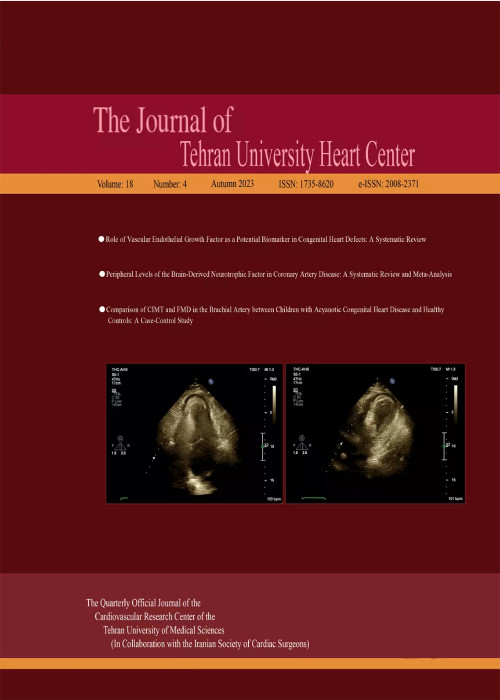Correlates of the? No-Reflow? or? Slow-Flow? Phenomenon in Patients Undergoing Primary Percutaneous Coronary Intervention
Author(s):
Article Type:
Research/Original Article (دارای رتبه معتبر)
Abstract:
Background
Despite recent advances in interventional equipment and techniques, the angiographic no-reflow phenomenon occurs in a considerable number of patients undergoing primary percutaneous coronary intervention (PCI). We investigated the clinical, angiographic, preprocedural, and procedural characteristics associated with the no-reflow phenomenon among patients undergoing primary PCI.
Methods
Between March 2008 and April 2013, 530 patients (78.5% male, mean age=58.11±12.39 y) with ST-segment-elevation myocardial-infarction who underwent primary PCI were categorized in 2 groups according to their postprocedural thrombolysis-in-myocardial infarction (TIMI) flow grades: those with a maximum score of 2 (the no-reflow or slow-flow group) and the ones with a score of 3 (the reflow group). A multivariable logistic regression model was used to find the multiple correlates of the no-reflow phenomenon after PCI.
Results
There were 166 (31.3%) patients in the no-reflow group and 364 (68.7%) in the reflow group. The no-reflow patients were older and had significantly longer target lesion lengths, higher SYNergy between percutaneous coronary intervention with TAXus and cardiac surgery (SYNTAX) scores, higher infarct-related artery SYNTAX scores, more thrombus burden, and a higher frequency of initial TIMI flow grades of 2 or lower. Our multivariable logistic regression analysis demonstrated that older age, higher numbers of Q waves, not using statin, longer target lesion lengths, higher thrombus grades, and higher infarct-related artery SYNTAX scores remained the independent correlates of increased no-reflow rates after primary PCI (area under the ROC curve=0.784, 95% CI: 0.742–0.826; P<0.001).
Conclusion
Clinical, angiographic, and procedural features of patients undergoing primary PCI may be correlated with the occurrence of the no-reflow phenomenon. The thrombus grade and the infarct-related artery SYNTAX score could be among these factors.Language:
English
Published:
The Journal of Tehran University Heart Center, Volume:13 Issue: 3, Jul 2018
Pages:
108 to 114
magiran.com/p1883999
دانلود و مطالعه متن این مقاله با یکی از روشهای زیر امکان پذیر است:
اشتراک شخصی
با عضویت و پرداخت آنلاین حق اشتراک یکساله به مبلغ 1,390,000ريال میتوانید 70 عنوان مطلب دانلود کنید!
اشتراک سازمانی
به کتابخانه دانشگاه یا محل کار خود پیشنهاد کنید تا اشتراک سازمانی این پایگاه را برای دسترسی نامحدود همه کاربران به متن مطالب تهیه نمایند!
توجه!
- حق عضویت دریافتی صرف حمایت از نشریات عضو و نگهداری، تکمیل و توسعه مگیران میشود.
- پرداخت حق اشتراک و دانلود مقالات اجازه بازنشر آن در سایر رسانههای چاپی و دیجیتال را به کاربر نمیدهد.
In order to view content subscription is required
Personal subscription
Subscribe magiran.com for 70 € euros via PayPal and download 70 articles during a year.
Organization subscription
Please contact us to subscribe your university or library for unlimited access!


